The Ultimate Teeth Whitening Guide You Should Know
Imagine you are getting ready for a wedding. From selecting the perfect outfit to styling your hair, everything is top-notch. Suddenly you notice that your teeth aren’t as bright as you’d like them to be, and all your confidence fades away. Don’t worry; we have all been there!
So no more hiding your smile because of yellow or stained teeth. We have brought you the ultimate teeth whitening guide you should know. We will share everything you need to know to achieve that radiant smile of your dreams. Get ready to unlock the secrets of a whiter and brighter smile with us.
What is Teeth Whitening
Teeth whitening is a cosmetic dental procedure that aims to lighten the color of your teeth and remove any discoloration or stains. This is typically done by using chemical agents or laser therapy. The primary goal of teeth whitening is to enhance the appearance of your smile, giving you a brighter and more confident look.
Why Teeth Whitening is Important
Let’s face it, in a world where appearance matters more than ever, having a bright and white smile is crucial. Teeth whitening not only enhances the overall look. It also boosts self-confidence. Our teeth naturally become yellowish or stained from our food and drinks as we age. This can make us feel conscious about smiling or talking in public. By opting for teeth whitening treatments, we can reverse these effects and regain that dazzling smile we have always wanted.
Along with the cosmetic benefits, maintaining good dental hygiene is essential. Neglecting dental hygiene can lead to tooth decay and gum disease. As a result, it jeopardizes oral health. Moreover, a minor issue can be linked to conditions like diabetes or oral infections. So investing in teeth whitening is not just about looking good; it is about taking care of overall well-being.
Types of Tooth Discoloration
When it comes to tooth discoloration, there are two main types to consider: extrinsic staining and intrinsic staining.
Extrinsic Staining
Extrinsic staining occurs when the outer layer of the tooth, known as the enamel, becomes stained or discolored. This discoloration is commonly caused by tobacco use, certain foods and beverages like coffee, tea, and red wine, poor oral hygiene, and certain medications. The stains appear as yellow or brownish patches on the teeth and are easily noticeable.
Intrinsic Staining
Intrinsic staining occurs within the structure of the tooth itself. It happens when the dentin darkens or becomes discolored. This staining can be caused by various factors such as trauma to the tooth, excessive fluoride exposure during childhood, certain medications (such as tetracycline antibiotics), genetics, or aging. Regular brushing cannot remove intrinsic staining manifested as gray or yellow-brown spots.
Causes of Tooth Staining
Tooth staining is a common problem that affects individuals of all ages. Most people assume that stains are solely caused by poor oral hygiene. However, there are actually a multitude of factors that contribute to the discoloration of teeth.
Age and genetics: As we age, the outer layer of enamel on our teeth naturally thins out due to wear and tear. This exposes the underlying dentin, which has a slightly yellowish tone. Additionally, genetics play a role in determining our tooth color. Some people are simply more prone to tooth staining than others based on inherited traits.
Food and Drinks: Certain foods and drinks can cause tooth staining due to their high content of chromogens, which are intense color pigments. This includes beverages like coffee, tea, red wine and foods like berries, soy sauce, and curry. These substances can penetrate the enamel layer of the teeth, leading to discoloration over time.
Tobacco: Tobacco use is another major cause of tooth staining. Both smoking cigarettes and using smokeless tobacco products can result in yellow or brownish stains on the teeth. Moreover, smoking also reduces saliva production, which is crucial in protecting the teeth from stains and maintaining their natural whiteness.
Poor oral hygiene: Poor oral hygiene practices play a significant role in tooth staining. When we neglect regular brushing and flossing, plaque buildup occurs. Over time, this plaque absorbs pigments from food and drinks ingested, leading to tooth discoloration. Moreover, plaque can lead to decay, gum disease, and hamper oral activity.
Medications: Some medications, such as antibiotics like tetracycline, may also contribute to tooth staining as a side effect. This mainly affects children whose permanent teeth haven’t fully formed yet.
How to Maintain Your White Teeth
Maintaining white teeth is a priority for many individuals, but it is like an uphill battle. Remember, consistency is vital to maintaining good oral hygiene practices. Below are some general rules you may follow to preserve your white teeth:
Brush your teeth using the right technique: Proper brushing techniques can take your oral hygiene routine to the next level. Use a soft-bristled toothbrush and gentle circular motions to remove plaque effectively without damaging your enamel. Pay attention to all areas of your mouth, including the back of your teeth and the gum line.
Avoid foods and drinks that stain your teeth: Dark-colored beverages like coffee, tea, red wine, and soda can stain your teeth. Limiting your consumption or using a straw to minimize contact with your teeth can help maintain their white appearance.
Be mindful of certain foods: Acidic fruits such as lemons and oranges can erode the enamel, making it easier for stains to penetrate. Similarly, highly pigmented food like berries and tomato sauce should be consumed in moderation to prevent discoloration.
Opt for whitening products carefully: Teeth whitening strips or gels with hydrogen peroxide can brighten your smile but should be used sparingly. Overuse of these products may lead to sensitivity or damage to the enamel. It’s best to consult with a dental professional before starting any whitening treatment.
Go for dental check-ups: Regular dental check-ups are crucial in maintaining white teeth. Dentists have the expertise to identify early signs of discoloration or staining. Additionally, professional cleanings during these appointments can remove stubborn stains that regular brushing may miss.
Use natural teeth whiteners: Natural teeth whiteners are a great alternative to expensive whitening treatments. Using baking soda and activated charcoal can help remove surface stains and give your teeth a natural shine. However, it’s essential to remember that these products should be used in moderation.
Wrap Up
Regarding teeth whitening, it’s essential to be well-informed and use caution. The ultimate guide here offers valuable tips and insights for achieving a brighter smile. By following the above simple tips, you can maintain white teeth and achieve a brighter smile. Remember that maintaining white teeth is not a one-time effort but an ongoing commitment to good dental care.



